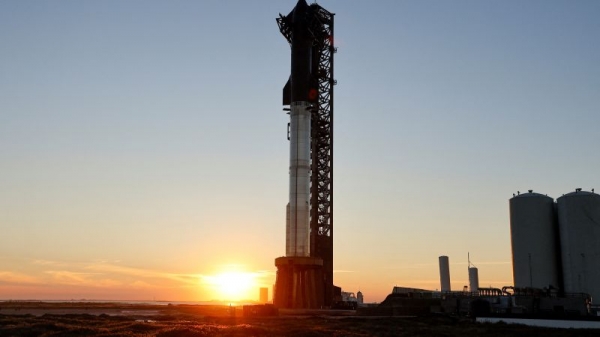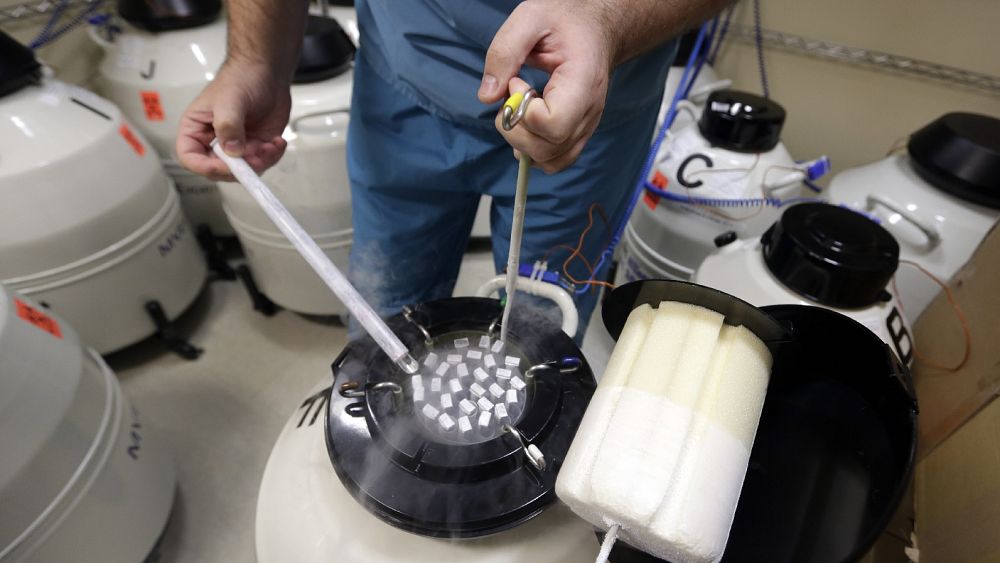
Sign up for CNN’s Wonder Theory science newsletter. Explore the universe with news on fascinating discoveries, scientific advancements and more.
After months of rebuilding and clearing red tape following the April explosion of the Starship system’s first test flight, SpaceX is set for its next attempt.
The megarocket — the most powerful launch vehicle ever built — was expected to lift off on Friday, but SpaceX CEO Elon Musk said in a social media post Thursday that the company would hold off until Saturday to allow for time to replace a small rocket part.
The company is targeting a 20-minute launch window that opens Saturday at 7 a.m. CT (8 a.m. ET), according to the SpaceX website.
Musk shared that the reason for the delay was the need to replace an actuator — or a mechanical component that allows movement — on one of the rocket’s grid fins. Grid fins are metal, mesh squares that line the top of Starship’s Super Heavy rocket booster, and they’re used to orient the booster as it heads in for a landing after flight.
Riding on Starship’s eventual success is the company’s hopes for human exploration of the moon and Mars.
The Starship spacecraft stacked atop the Super Heavy booster is intended to play a key role in the NASA Artemis III moon mission, currently slated for 2025. How the launch attempt fares could have a deep impact on the US space agency’s lunar exploration goals.
SpaceX will carry a live stream of the launch from the company’s Starbase facility in Boca Chica, Texas. CNN will also provide live updates.
The inaugural integrated test flight of Starship and Super Heavy in April ended just minutes after takeoff when the vehicle began tumbling tail-over-head, forcing SpaceX to initiate self-destruct mode and explode both rocket stages over the Gulf. Debris rained down over parts of the South Texas landscape, sparking outcry among environmental and wildlife groups.
Local officials are expected to keep people far away from the launch site, recommending a viewing location about 5 miles (8 kilometers) across the water on Texas’ South Padre Island.
What to expect
Standing at 397 feet (121 meters) tall, the gargantuan rocket consists of two parts: the upper spacecraft, referred to as Starship, and the lower first-stage booster, called Super Heavy, that gives the initial burst of power at liftoff.
If all goes according to plan, the Super Heavy will ignite up to 33 of its massive engines and vault the Starship capsule out over the Gulf of Mexico. After its fuel is spent, the Super Heavy will detach from the Starship spacecraft and fall back toward the ocean.
Starship will then ignite its own engines and attempt to propel itself to speeds quick enough to enter Earth’s orbit, a feat that typically requires spacecraft to travel about 5 miles (8 kilometers) per second.
“Technically it’s a scooch below orbit because it’s going to do almost a complete circuit of the Earth but then splash down somewhere in the Pacific just off the coast of Hawaii,” said Musk, referring to the upcoming flight test, on October 5 during the International Astronautical Congress in Baku, Azerbaijian.
All told, the mission will likely last about an hour and a half.
Musk’s Starship hopes and what’s at stake
If successful, the test flight will be considered a monumental step, queuing up SpaceX to begin testing far more complex Starship missions, including delivering satellites to orbit and attempting to refuel the spacecraft while it’s in orbit. Being able to top off the ship’s fuel in space could allow it to complete missions deeper into the cosmos.
If the test mission fails, the consequences will have a ripple effect, potentially pushing back deadlines for SpaceX’s — and NASA’s — stated goals for the rocket system.
SpaceX has framed Starship as the rocket that will fulfill the company’s founding purpose: Put humans on Mars for the first time and pave the way for a permanent Martian settlement.
Musk has said he thinks the first test flight to Mars could take place within the next “three or four years,” though he’s known for offering overly optimistic time frames.
Perhaps closer on the horizon is the mission that NASA is hoping Starship will help fulfill. The space agency intends to land humans on the moon — returning US astronauts there for the first time in five decades — as part of its Artemis program. And Starship is slated to complete the final leg of the journey, taking the astronauts from their spacecraft in lunar orbit and ferrying them down to the moon’s surface.
SpaceX received a $2.89 billion contract from NASA in 2021 to get the job done, with another deal worth up to $1.15 billion awarded a year later. The company will receive payments as it completes certain milestones in Starship’s development.
NASA hopes the first moon landing using Starship will take place as soon as late 2025.
“With the difficulties that SpaceX has had, I think that’s really concerning,” said Jim Free, associate administrator of NASA’s Exploration Systems Development Mission Directorate, in June. “You can think about that launch date slipping probably into ’26.”
The US space agency is aiming to put boots on the moon sooner rather than later, as it’s racing against China to create the first permanent lunar base.
What success looks like for SpaceX
High hopes aside, SpaceX has been known to embrace fiery mishaps and explosions in the early stages of developing a new rocket.
SpaceX has said its approach to rocket development is geared toward speed. The company makes use of an engineering method called “rapid spiral development.” That essentially boils down to a desire to quickly build prototypes and willingly blow them up in the name of learning how to construct a better one — faster than if the company solely relied on ground tests and simulations.
After the first test flight’s explosion, the company immediately sought to frame the mishap as a success, saying in a statement at the time, “With a test like this, success comes from what we learn, and we learned a tremendous amount.”
Previous explosions have grounded a rocket for a year or more. But SpaceX quickly developed a new prototype, implemented “thousands” of upgrades, and was ready to fly another test vehicle in early September, according to updates shared by Musk on social media.
Musk has said that the company has made enhancements to both the Starship spacecraft and the Super Heavy booster design to incorporate lessons learned from the first launch.
The launchpad, for example, was blown to bits after the inaugural launch because of the sheer force of the Super Heavy booster’s engines. SpaceX has since equipped the pad with a water deluge system that will spew water up as the engines ignite, dampening their blast and hopefully sparing the pad. Musk has likened the contraption to a colossal showerhead.
SpaceX is also changing the method Starship will use to break away from the Super Heavy booster midflight, opting to use the Starship’s own engines to push away, rather than a separate mechanical system.
It’s not clear whether all those changes will lead to success.
“I do want to set expectations, well, not too high,” Musk said at the October conference when asked about his goals for this test mission.
Musk also posted in August on social media that he foresees about a “50% probability of reaching orbital velocity,” though he cautiously added that “even getting to stage separation would be a win,” referring to the launch phase when the Super Heavy rocket detaches from the Starship spacecraft.
Those are still better odds than Musk gave the April test flight, which he had said would have been a success if the rocket made it off the launchpad.
Regulators and environmentalists
Starship couldn’t fly when SpaceX first claimed it was ready in September due to regulatory hurdles. The company was still waiting on the Federal Aviation Administration, which licenses commercial rocket launches, to close an investigation into the explosive April test flight and issue a new launch license.
William Gerstenmaier — SpaceX’s vice president for build and reliability who previously served as NASA’s associate administrator for human exploration — blasted the regulatory process during an October US Senate hearing, accusing them of hamstringing Starship’s development.
“It’s a shame when our hardware is ready to fly, and we’re not able to go fly because of regulations or review,” Gerstenmaier said. “These delays may seem small in the big scheme of things but … delays in each and every test flight adds up. And eventually we will lose our lead and we will see China land on the moon before we do.”
On the other end of the spectrum, however, are environmentalists, who say the FAA isn’t doing nearly enough to ensure the company is not damaging the public lands and wildlife refuges that surround SpaceX’s South Texas launch site.
One group of activists sued the FAA in May, alleging regulators had failed to comply with federal environmental law when they greenlit Starship’s April test flight. That case is ongoing, and the FAA could face another complaint over the second launch license, which was issued Wednesday by the federal agency, a senior attorney for the Center for Biological Diversity, Jared Margolis, told CNN November 8.
The environmental groups have protested SpaceX testing operations, saying its explosive mishaps have spewed shrapnel onto public beaches and into the nearby wildlife reserves, in addition to burning acres of land with unintended brush fires.
SpaceX, which is involved in the case as an intervener, denied many of the allegations in the lawsuit but admitted its testing operations have flung debris into nearby areas. But both SpaceX and the FAA maintain that they have complied with federal environmental laws.
In a written reevaluation of its environmental assessment signed by the FAA on Wednesday, the agency noted that SpaceX made changes at the launchpad that could reduce the amount of debris generated by the next test flight.
The agency also concluded, “New information from the first launch and ongoing monitoring does not present any significant new circumstances or information relevant to environmental concerns.”
SpaceX did not respond to a request for comment for this story, nor does the company typically respond to inquiries from reporters.
This story has been updated to reflect the latest expected timing for the launch.



